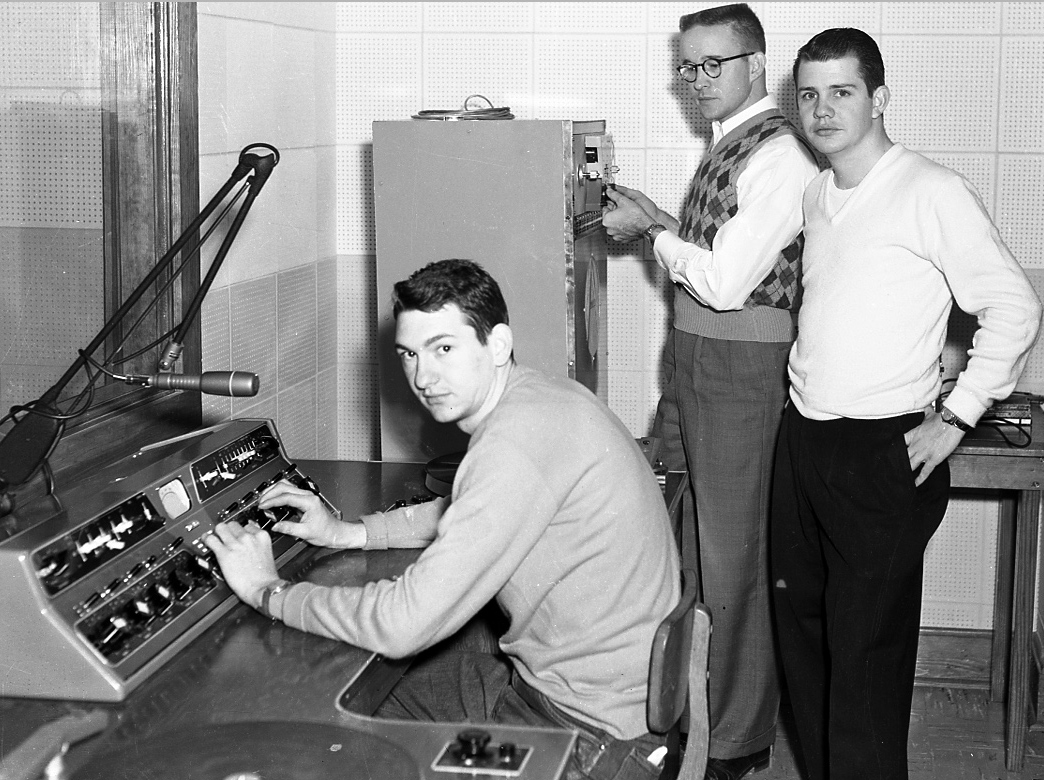KASU Celebrates 60th Anniversary as State’s Oldest Public Medium
By Mike Doyle, KASU Station Manager
JONESBORO — When KASU first signed on the air May 17, 1957, from studios in Wilson Hall, the term “public broadcasting” had not yet developed. Today, 91.9 FM delivers a variety of content, using additional technologies, to different recipients than its visionary founders might have imagined.
Sixty years after that sign-on, KASU is the public media service — not just the radio service — of Arkansas State University. The station streams its signal around the world on www.kasu.org. KASU has an active website providing continuous news content from NPR, AP, Arkansas Public Media and the KASU news department. The station has a presence on social media outlets such as Facebook and Twitter and has begun to provide live Facebook streams of certain public events such as news conferences, public discussions and meetings.
Beginnings and Growth
Even before that 1957 launch, the A-State administration endorsed the effort to get a radio station licensed to the school. A-State was known as Arkansas State College (ASC) in 1953 when a member of the journalism faculty was given permission to contact the Federal Communications Commission (FCC) about the possibility of launching a station on the campus.
The ideal call letters – KASC (for Arkansas State College) — were available. But by the time ASC’s application was officially submitted, those letters had been assigned to another ASC: Arizona State College. The president of Arkansas State in Jonesboro, Dr. Carl R. Reng, believed that the school would achieve university status in the future and approved the submission of call letters KASU. The commission approved construction of a station to be known as KASU on 91.9 megahertz. In 1967, 10 years after the station’s initial sign-on, Reng’s prediction of Arkansas State University proved correct and the call letters fit.
For its first two decades or so, KASU broadcast, with the guidance of faculty and professional staff, a schedule of student-produced recorded music (deejay) and campus talk shows, live fine arts concerts, visiting lecturers, commencement exercises and A-State sports. This fulfilled the administration’s vision of a valuable public relations tool for the campus.
During the early period, the station’s original broadcasts came from a 760-watt transmitter located in instructor Charles Rasberry’s office near the Wilson Hall control booth. About 1967, when the station was granted a power increase to 3,500 watts, a new transmitter and tower were relocated on the northeastern edge of the campus.
From the 1980s to the present day, technical, economic and political changes began to affect broadcasting operations everywhere, including KASU. Automation began to make radio operation more efficient by decreasing the amount of live operation broadcast hours; A-State sports events were licensed to a series of outside media vendors; and Congress made changes in the Public Broadcasting Act, requiring public radio and public television to more closely resemble commercial broadcasting by striving for higher ratings and soliciting corporate support.
As the licensee of Arkansas State University, KASU has always been connected to an academic unit that prepares students for careers in media and communication while continuing to serve the campus. The station was granted a power increase to 100,000 watts in 1973, with a new tower and transmitter site north of the Jonesboro city limits. While the analog signal still reaches 25 to 30 counties in northeast Arkansas, southeast Missouri and western Tennessee, a steadily increasing number of listeners prefer to pick up KASU’s digitally streamed signal from the internet on their desktop and laptop computers, tablets and cell phones.
KASU “Firsts”
- First local broadcast station in the Jonesboro area to pre-empt regular programs during the frequent periods of severe Mid-South weather to broadcast watches, warnings and safety tips to the public. (1973)
- First station in the area to receive regular daily programming by satellite. (1981)
- First broadcast station in the region to offer an extensive block of blues programming on the weekend — “nothing but the blues” — on Saturday night. (1995)
- First broadcasting station in the area to broadcast regularly scheduled live interviews with U.S. senators and representatives from Arkansas and the region. (1998)
- First station in Arkansas to offer a daily program devoted exclusively to Arkansas’s current music scene and to the Natural State’s musical heritage. (Arkansas Roots, 2013)
Birthday celebration
Listeners, supporters and friends are invited to purchase tickets and to attend the 60th birthday sock-hop celebration in the Grand Hall of the Fowler Center Saturday, May 20, from 6 to 9 p.m. Period themed attire is optional.
Memphis’ Brandon Cunning Band and Arkansas’s own Sonny Burgess and the Legendary Pacers will provide the sounds of the 1950s period. Food and drinks are included with the purchase price of $20. Tickets are available at the A-State Box Office or by calling (870) 972-2781. Seating is limited.
# # #







